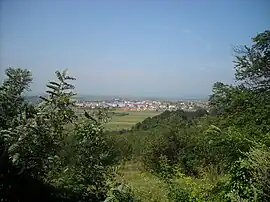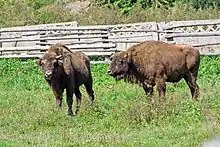Hațeg | |
|---|---|
 Hațeg panorama | |
 Coat of arms | |
 Location in Hunedoara County | |
 Hațeg Location in Romania | |
| Coordinates: 45°36′27″N 22°57′0″E / 45.60750°N 22.95000°E | |
| Country | Romania |
| County | Hunedoara |
| Government | |
| • Mayor (2020–2024) | Adrian-Emilian Pușcaș[1] (PNL) |
| Area | 64.33 km2 (24.84 sq mi) |
| Population (2021-12-01)[2] | 8,793 |
| • Density | 140/km2 (350/sq mi) |
| Time zone | EET/EEST (UTC+2/+3) |
| Vehicle reg. | HD |
| Website | primariehateg |

Hațeg (Romanian pronunciation: [ˈhat͡seg]; German: Wallenthal; Hungarian: Hátszeg) is a town in Hunedoara County, Romania with a population of 9,340. Three villages are administered by the town: Nălațvad (Nalácvád), Silvașu de Jos (Alsószilvás), and Silvașu de Sus (Felsőszilvás). It is situated in the historical region of Transylvania.
History
In 1765, while part of the Habsburg controlled Principality of Transylvania, the settlement was completely militarised and integrated into the Second Border Company of the First Border Regiment from Orlat, until 1851, when that unit was disbanded.
Geology
Țara Hațegului (the Hațeg Country) is the region around the town of Hațeg. The fossils found in the Hațeg area span over 300 million years of Earth's geologic history, showing tropical coral reefs and volcanic island in the Tethys Sea, dinosaurs, primitive mammals, birds, and Pterosaurs (such as Hatzegopteryx, which was named for the region).
Hațeg Island was an island during the Cretaceous Period where a dwarf species of sauropod dinosaur, Magyarosaurus dacus, lived until their extinction at the end of the Cretaceous. Baron Franz Nopcsa published articles about these Mesozoic-era archosaurs on Hațeg Island. His studies led to his theory of insular dwarfism, the notion that "limited resources" on small islands can lead to a downsizing of the indigenous vertebrate animals.[3]
Since 2015 the area has been an UNESCO Global Geopark.[4]
Demographics
According to the first ethnic census of 1850, the town had 1,194 inhabitants, 915 of them being Romanian, 92 Roma, 77 Hungarian, 62 German (more specifically Transylvanian Saxons), and 48 of other ethnicities.[5] According to the 2011 census, Hațeg had 9,685 inhabitants, of which 93.15% were Romanians, 1.6% Hungarians, 1,1% of other ethnicities, and unknown for 4,14% of the population.[5] At the 2021 census, the town had a population of 8,793.[6]
| Year | Pop. | ±% p.a. |
|---|---|---|
| 1850 | 915 | — |
| 1880 | 1,808 | +2.30% |
| 1900 | 2,367 | +1.36% |
| 1912 | 3,124 | +2.34% |
| 1930 | 3,383 | +0.44% |
| 1948 | 3,210 | −0.29% |
| 1956 | 3,853 | +2.31% |
| 1966 | 5,631 | +3.87% |
| 1977 | 8,423 | +3.73% |
| 1992 | 11,616 | +2.17% |
| 2002 | 12,507 | +0.74% |
| 2011 | 9,685 | −2.80% |
| 2021 | 8,793 | −0.96% |
| Source: Census data | ||
Natives
Gallery
 European bison in Hațeg nature reserve
European bison in Hațeg nature reserve The I. C. Brătianu National College
The I. C. Brătianu National College.JPG.webp) Saint Nicholas Orthodox Church
Saint Nicholas Orthodox Church.JPG.webp) Historic bank building, today Hotel Ferdinand
Historic bank building, today Hotel Ferdinand.JPG.webp) Reformed Church
Reformed Church Synagogue
Synagogue.JPG.webp) Nalatzi-Fay Manor, Nălațvad. Now in poor condition, was built in the 19th century. Between 1941 and 1944 some of the rural Jews were interned here.
Nalatzi-Fay Manor, Nălațvad. Now in poor condition, was built in the 19th century. Between 1941 and 1944 some of the rural Jews were interned here. Trajan's Road near Hațeg (1900-1920)
Trajan's Road near Hațeg (1900-1920) Interior of the Greek-Catholic Church (1900-1920)
Interior of the Greek-Catholic Church (1900-1920)
See also
References
- ↑ "Results of the 2020 local elections". Central Electoral Bureau. Retrieved 8 June 2021.
- ↑ "Populaţia rezidentă după grupa de vârstă, pe județe și municipii, orașe, comune, la 1 decembrie 2021" (XLS). National Institute of Statistics.
- ↑ Csikia, Z.; M. J. Benton (2010). "An island of dwarfs — Reconstructing the Late Cretaceous Hațeg palaeoecosystem". Palaeogeography, Palaeoclimatology, Palaeoecology. 293 (3–4): 265–270. doi:10.1016/j.palaeo.2010.05.032.
- ↑ "Haţeg UNESCO Global Geopark". Retrieved 24 March 2023.
- 1 2 "ERDÉLY ETNIKAI ÉS FELEKEZETI STATISZTIKÁJA" (PDF).
- ↑ "Populația rezidentă după grupa de vârstă, pe județe și municipii, orașe, comune, la 1 decembrie 2021" (in Romanian). INSSE. 31 May 2023.
External links
 Hațeg travel guide from Wikivoyage
Hațeg travel guide from Wikivoyage- Hațeg City Hall Official Site (in Romanian)
